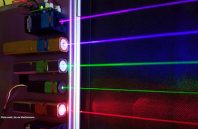Quantum dots, semiconductor particles small enough in size that single electrons can be confined within the structures, are a promising source of laser light for certain applications, but their practical use has posed some challenges.
Although the laser output can be effectively tuned through careful choice of the semiconductor material employed and the dimensions of the quantum dot, any minuscule defects in the structure tend to split the output into multiple wavelengths, reducing the power and utility of the beam.
A project led by the University of Utah has developed a possible solution in which two such microdisk optical resonators are evanescently coupled, producing spectra in which the mode-splitting is reduced. The work was published in Nature Communications.

 (585) 768-2513
(585) 768-2513

